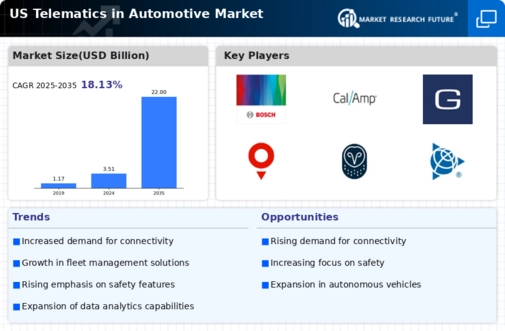Advancements in Connectivity Technologies
The rapid advancements in connectivity technologies are significantly influencing the telematics in-automotive market. The proliferation of 5G networks is enabling faster data transmission and more reliable communication between vehicles and infrastructure. This enhanced connectivity allows for real-time data sharing, which is essential for applications such as vehicle-to-everything (V2X) communication. As of 2025, it is estimated that nearly 50% of new vehicles will be equipped with advanced telematics systems that leverage 5G technology. This shift not only enhances the driving experience but also supports the development of smart transportation systems, thereby driving growth in the telematics market.
Consumer Preference for Connected Vehicles
Consumer preferences are shifting towards connected vehicles, which is a significant driver for the telematics in-automotive market. As drivers increasingly seek features such as navigation, entertainment, and safety alerts, automakers are compelled to integrate telematics solutions into their vehicles. Research indicates that approximately 70% of consumers in the US express a preference for vehicles equipped with advanced connectivity features. This growing demand is prompting manufacturers to invest in telematics technologies, which are expected to enhance user experience and satisfaction. Consequently, the telematics market is likely to witness a compound annual growth rate (CAGR) of around 12% over the next few years.
Regulatory Compliance and Safety Standards
Regulatory compliance is a critical driver for the telematics in-automotive market. In the US, stringent regulations regarding vehicle safety and emissions are prompting manufacturers to integrate advanced telematics systems. For instance, the National Highway Traffic Safety Administration (NHTSA) has established guidelines that encourage the use of telematics for monitoring vehicle performance and safety features. As a result, automakers are increasingly investing in telematics solutions to ensure compliance and enhance safety. This trend is expected to contribute to a projected growth rate of 15% in the telematics market by 2026, as companies strive to meet regulatory requirements while improving overall vehicle safety.
Growing Demand for Fleet Management Solutions
The telematics in-automotive market is experiencing a notable surge in demand for fleet management solutions. Companies are increasingly adopting telematics systems to enhance operational efficiency, reduce costs, and improve vehicle utilization. In 2025, the fleet management segment is projected to account for approximately 30% of the overall telematics market. This growth is driven by the need for real-time tracking, route optimization, and maintenance alerts, which collectively contribute to better decision-making and resource allocation. As businesses recognize the value of data-driven insights, the adoption of telematics solutions is likely to expand, thereby propelling the telematics in-automotive market forward.
Integration of Artificial Intelligence and Data Analytics
The integration of artificial intelligence (AI) and data analytics into telematics systems is emerging as a pivotal driver for the telematics in-automotive market. AI technologies enable the analysis of vast amounts of data generated by vehicles, leading to improved predictive maintenance, enhanced safety features, and personalized driving experiences. In 2025, it is anticipated that AI-driven telematics solutions will account for nearly 25% of the market share. This trend reflects a growing recognition of the value of data analytics in optimizing vehicle performance and enhancing user engagement. As manufacturers increasingly adopt AI technologies, the telematics market is poised for substantial growth.

























Leave a Comment